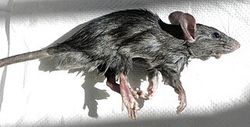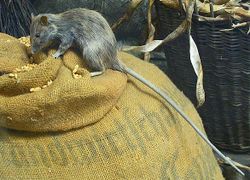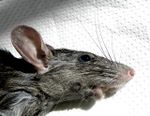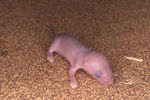Black rat
| Black rat |
|---|

|
| Scientific Classification |
|
| Scientific Name |
|
Rattus rattus |

|
| Rattus rattus sitting on top of a sack of grain |
The Black rat or Rattus rattus, also known as the ship rat, is very common and is quite a nuisance. They are found all over the world on almost every continent. The Black rat mostly stays in large packs or colonies in coastal areas.[2] They are usually 'stowaways' on large ships (which is how they got their nickname, the ship rat) which is how they have spread so quickly overseas. [3][2] The Black rat is a large animal (approximately 13-18 inches long) with large ears and a long tail.[2] They can have anywhere between 3-10 babies and it's life cycle is about 2 years long. [4] The Black rat is a nuisance because they invade homes and spread disease. For instance, the Black plague was spread by the fleas that were living on the Black rat. [5]
Body Design
The Black rat or Rattus rattus is usually 16-22 cm long with a tail that can be 19 cm or longer. They weigh between 150-250 g. The males are quite often longer and heavier than the females.[2]
The Black rats have medium size bodies and are smaller than the brown rat. They have relatively large ears and course, long fur. Their sparsely-haired, scaly tails are almost always longer than their head and body combined. Their bodies are Black and have a light colored ventral belly.[2][6]
Life Cycle
The black rats’ life cycle is all together about two years long. A female rats litter can be anywhere from 3 to 10 baby rats, and the time. And it takes 3 to 4 months for each baby to fully mature. [7] When a litter of black rats are born they are hairless and have shut eyes. it only takes about a week or two for them to grow hair and to have there eyes open. once there eyes have fully opened they can start to move around the nest and look for food. a baby rat will be nursed for about 5 weeks until they learn how to act like there mother and learn how to find food.[8]
Ecology
The black rat is often found in large numbers in coastal areas due to the species being spread through human seafaring. Since the rat is an agile climber it can be found living in high places such as trees in forested areas or top floors of buildings in areas that are populated by man. Even though it may be found near water, Rattus rattus rarely swims. Though it used to be common in towns and farms in mild regions it has been driven out in large numbers by Rattus norvegicus, which is more aggressive. The black rat can live in temperate, tropical, and terrestrial regions. The species was originally native to India and Pakistan, but is now found on almost every continent! [9]
Rattus rattus is an omnivore that generally feeds on grain, fruit, cereal, and other plants and vegetation. If food is in short supply, the rat will eat insects or other invertebrates. Rattus rattus is found basically anywhere that can support the rat's omnivorous diet.[2]
In domestic areas, Rattus rattus is prey for cats (Felis silvestris) and owls, while in less urban areas weasels, foxes, and coyotes feed on them. Snakes and hawks are also potential predators.[10]
Invasive Species
Location and Method of Introduction The black rat is found on all of the continents. And it is found in costal regions. The way that the black rat gets to these coastal regions around the world is by riding on large ships that take goods around the world.[2]
Environmental Impact The black rat is responsible for the extinction of many plants and animal species. they interrupt the natural food chain in the areas that they are invading, as well as spreading diseases throughout the regions that they are invading. They have drastically decreased the population of island birds because they eat the birds eggs.[11]
Control Methods Large scale control methods have been created to keep the population of these rats balanced, in order to keep some species in new Zealand and other countries, off the endangered list. Pesticides that are usually distributed by helicopters for large areas infested with the black rat help control mass infestations on islands. The most common type of pesticide used for this is called sodium fluoroacetate or "pindone". Poison control methods have been used to keep the Rattus rattus population at a size that is not threatening. In order to experiment on and track the population of the black rat, bait traps and colored dyes are used to catch, kill or tag them. Yet, despite all these control methods, the population often rebounds right back in a few months![12]
Video
References
- ↑ Rattus rattus [1] Wikispecies. Web. November 2, 2016. (accessed.). (Author unknown)
- ↑ 2.0 2.1 2.2 2.3 2.4 2.5 2.6 Gillespie, Heather. Rattus rattus: house rat Animal Diversity. Web. Accessed November 14, 2016.
- ↑ Black rat (Rattus rattus) http://www.wildcru.org. Web. March, 2011. (last-modified - Published 1998)Author unknown.
- ↑ Veitch, Dick Rattus rattus (mammal) Global Invasive Species Database. Web. October 30, 2016.
- ↑ Pruitt, Sarah Medieval “Black Death” Was Airborne, Scientists Say Web. April 1, 2014 (Published April 1, 2014.).
- ↑ Hopkins Johns, discoverlife The McDonald & Woodward Publishing Company, Inc. April 10, 2002
- ↑ Veitch, Dick. Rattus rattus (mammal) Global Invasive Species Database. Web. Last modified October 30, 2016.
- ↑ Reproduction and Development Internet Center For Wildlife Damage management. Web. November 5, 2016.Author Unknown.
- ↑ Rattus rattus Red list. Web. October 30, 2016. (date accessed)unknown author
- ↑ Rattus rattus Red list. Web. October 30, 2016. (date accessed)unknown author
- ↑ Shiels, Aaron. Rattus rattus (black rat) Invasive Species Compendium. Web. November 7, 2016.
- ↑ [2] Wikipedia. Web.(accessed) November 6, 2016. .




